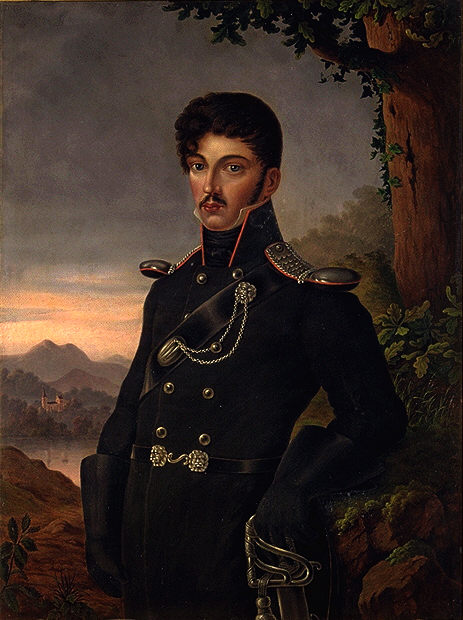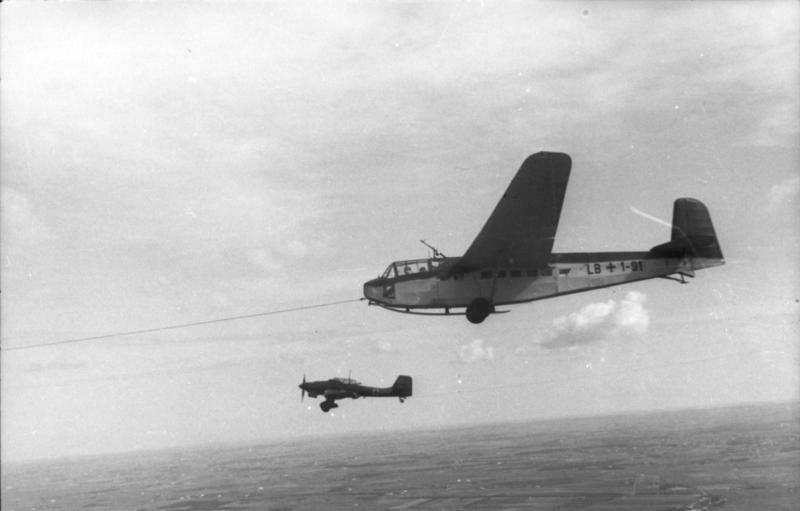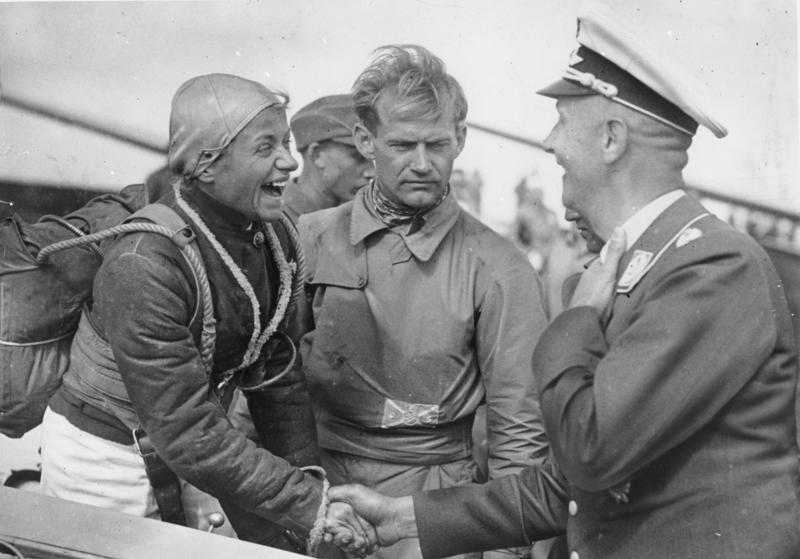|
Fieseler Fi 103R (Reichenberg)
The Fieseler Fi 103R, code-named ''Reichenberg'', was German manned version of the V-1 flying bomb (more correctly known as the ''Fieseler Fi 103''). It was developed towards the end of the Second World War and, although it never entered service, was intended to be used as a human-guided bomb in likely-suicidal attacks against the advancing Allies. The Fi 103R started development in 1944 at a time when Germany was anticipating a major naval landing by the Allies in western Europe. It was believed that a disposable aircraft armed with of explosives would potentially inflict heavy damage on important targets such as enemy shipping. However, these attacks would have very likely involved the death of the pilot, who was expected to exit the aircraft and parachute away mere moments before the aircraft's impact. These pilots were reportedly to be volunteers and aware of the risk to their own lives. The " Leonidas Squadron", V. ''Gruppe'' of the Luftwaffe's Kampfgeschwader 200, was e ... [...More Info...] [...Related Items...] OR: [Wikipedia] [Google] [Baidu] |
WikiProject Aircraft
A WikiProject, or Wikiproject, is a Wikimedia movement affinity group for contributors with shared goals. WikiProjects are prevalent within the largest wiki, Wikipedia, and exist to varying degrees within sister projects such as Wiktionary, Wikiquote, Wikidata, and Wikisource. They also exist in different languages, and translation of articles is a form of their collaboration. During the COVID-19 pandemic, CBS News noted the role of Wikipedia's WikiProject Medicine in maintaining the accuracy of articles related to the disease. Another WikiProject that has drawn attention is WikiProject Women Scientists, which was profiled by '' Smithsonian'' for its efforts to improve coverage of women scientists which the profile noted had "helped increase the number of female scientists on Wikipedia from around 1,600 to over 5,000". On Wikipedia Some Wikipedia WikiProjects are substantial enough to engage in cooperative activities with outside organizations relevant to the field at issue. For e ... [...More Info...] [...Related Items...] OR: [Wikipedia] [Google] [Baidu] |
Werner Baumbach
Werner Baumbach (27 December 1916 – 20 October 1953) was a German bomber pilot during World War II. He commanded the secret bomber wing Kampfgeschwader 200 (KG 200) of the Luftwaffe, the air force of Nazi Germany. Baumbach received the Knight's Cross of the Iron Cross with Oak Leaves and Swords for the destruction of over of Allied shipping. Career Baumbach entered the ''Luftwaffe'' in 1936 and, after initial training at the 2nd Air Warfare School ( Fliegerhorst Gatow), was trained as a bomber pilot. He was one of the first pilots to fly the Junkers Ju 88 bomber and flew various bombing missions with Kampfgeschwader 30 (KG 30). On 19 April 1940, he bombed and damaged the French cruiser ''Émile Bertin'' for which he was awarded the Iron Cross 1st Class. In 1942, Baumbach was removed from active pilot duty and started working on new bomber designs; among others, he helped design the composite bomber system, ''Mistel''. In 1944, he was placed in command of the newly formed Kamp ... [...More Info...] [...Related Items...] OR: [Wikipedia] [Google] [Baidu] |
Dannenberg (Elbe)
Dannenberg is a town in the district Lüchow-Dannenberg, in Lower Saxony, Germany. It is situated on the river Jeetzel, approx. 30 km north of Salzwedel, and 50 km south-east of Lüneburg. Dannenberg has a population of 8,147 inhabitants (December 2010). Dannenberg is located on the German Timber-Frame Road. It is the seat of the ''Samtgemeinde'' ("collective municipality") Elbtalaue. It has a soccer team which plays in the regional league, TSV Dannenberg. The actual history of the town began with the construction of the castle (first mentioned in 1153) during the rule of Volrad I, Count of Dannenberg (1153–1169), who had been given the task of settling and securing the territory by Duke Henry the Lion. The Waldemarturm is a local historical landmark, a tower in which the Danish King Valdemar II was imprisoned from 1223–1224. After World War II, Dannenberg was part of West Germany. However, it is situated very close to the Elbe river, which served as the border ... [...More Info...] [...Related Items...] OR: [Wikipedia] [Google] [Baidu] |
Ainring
Ainring is a municipality in the district of Berchtesgadener Land, Upper Bavaria, Germany, near the border to Austria. After World War II it was the site of a displaced persons camp. Personalities Sons and daughters Ainrings * Manuela Kraller (born 1981), singer Connected to Ainring * Eugen Sänger (1905-1964), engineer and pioneer in the field of aerospace * Hans Söllner Johann Michael Söllner (born 24 December 1955), better known as Hans Söllner, is a German singer-songwriter, who sings in Bavarian-German. Throughout German-speaking countries, especially in Bavaria and Austria, he is famous for publicly cr ... (born 1955), Bavarian singer-songwriter; lives in Ainring References Berchtesgadener Land Displaced persons camps in the aftermath of World War II {{BerchtesgadenerLand-geo-stub ... [...More Info...] [...Related Items...] OR: [Wikipedia] [Google] [Baidu] |
Deutsche Forschungsanstalt Für Segelflug
The ''Deutsche Forschungsanstalt für Segelflug'' (), or DFS , was formed in 1933 to centralise all gliding activity in Germany, under the directorship of Professor Walter Georgii. It was formed by the nationalisation of the Rhön-Rossitten Gesellschaft (RRG) at Darmstadt.Reitsch, H., 1955, The Sky My Kingdom, London: Biddles Limited, Guildford and King's Lynn, The DFS was involved in producing training sailplanes for the Hitler Youth and Luftwaffe, as well as conducting research into advanced technologies such as flying wings and rocket propulsion. Notable DFS-produced aircraft include the DFS 230 transport glider (1600+ produced), the German counterpart to the British Airspeed Horsa glider, and the DFS 194, similar to the famous Messerschmitt Me 163 rocket fighter. In 1938, following a fatal accident at the Wasserkuppe, DFS held a competition to design a more effective speed brake for gliders. The final design, produced by Wolfgang and Ulrich Hütter of Schempp-Hirth, is ... [...More Info...] [...Related Items...] OR: [Wikipedia] [Google] [Baidu] |
Fieseler Fi 103 Reichenberg 01 11
The Gerhard Fieseler Werke (GFW) in Kassel was a German aircraft manufacturer of the 1930s and 1940s. The company is remembered mostly for its military aircraft built for the Luftwaffe during the Second World War. History The firm was founded on April 1, 1930 as Fieseler Flugzeugbau Kassel by World War I flying ace and aerobatic champion Gerhard Fieseler. Fieseler had been a manager for the Raab-Katzenstein, but when this company went bankrupt, Fieseler bought a sailplane factory in Kassel and quickly turned it to building sports planes. At the same time, Fieseler still custom-built sailplanes for some of Germany's most prominent designers and pilots, including Wolf Hirth's "Musterle" and Robert Kronfeld's "Wien" and "Austria" (for many years the largest sailplane ever built). In 1934, the company achieved prominence when Fieseler won the World Aerobatics Championship in an aircraft his company had built, the F2 Tiger. This was followed by the highly successful F5, gener ... [...More Info...] [...Related Items...] OR: [Wikipedia] [Google] [Baidu] |
Liberec
Liberec (; german: Reichenberg ) is a city in the Czech Republic. It has about 103,000 inhabitants and it is the fifth-largest city in the country. It lies on the Lusatian Neisse, in a basin surrounded by mountains. The city centre is well preserved and is protected by law as an urban monument zone. Liberec was once home to a thriving textile industry and hence nicknamed the "Manchester of Bohemia". For many Czechs, Liberec is mostly associated with the city's dominant Ještěd Tower. Since the end of the 19th century, the city has been a conurbation with the suburb of Vratislavice nad Nisou and the neighbouring city of Jablonec nad Nisou. Therefore, the total area with suburbs encompasses 150,000 inhabitants. Administrative parts Liberec is made up of 32 city parts and one self-governing borough (Vratislavice nad Nisou). *Liberec I-Staré Město *Liberec II-Nové Město *Liberec III-Jeřáb *Liberec IV-Perštýn *Liberec V-Kristiánov *Liberec VI-Rochlice *Liberec VII-Horní ... [...More Info...] [...Related Items...] OR: [Wikipedia] [Google] [Baidu] |
Sudetenland
The Sudetenland ( , ; Czech and sk, Sudety) is the historical German name for the northern, southern, and western areas of former Czechoslovakia which were inhabited primarily by Sudeten Germans. These German speakers had predominated in the border districts of Bohemia, Moravia, and Czech Silesia since the Middle Ages. Sudetenland had been since the 9th century an integral part of the Czech state (first within the Duchy of Bohemia and later the Kingdom of Bohemia) both geographically and politically. The word "Sudetenland" did not come into being until the early part of the 20th century and did not come to prominence until almost two decades into the century, after World War I, when Austria-Hungary was dismembered and the Sudeten Germans found themselves living in the new country of Czechoslovakia. The ''Sudeten crisis'' of 1938 was provoked by the Pan-Germanist demands of Nazi Germany that the Sudetenland be annexed to Germany, which happened after the later Munich Agreeme ... [...More Info...] [...Related Items...] OR: [Wikipedia] [Google] [Baidu] |
Heinrich Himmler
Heinrich Luitpold Himmler (; 7 October 1900 – 23 May 1945) was of the (Protection Squadron; SS), and a leading member of the Nazi Party of Germany. Himmler was one of the most powerful men in Nazi Germany and a main architect of the Holocaust. As a member of a reserve battalion during World War I, Himmler did not see active service, and did not fight. He studied agriculture in university, and joined the Nazi Party in 1923 and the SS in 1925. In 1929, he was appointed by Adolf Hitler. Over the next 16 years, he developed the SS from a 290-man battalion into a million-strong paramilitary group, and set up and controlled the Nazi concentration camps. He was known for good organisational skills and for selecting highly competent subordinates, such as Reinhard Heydrich in 1931. From 1943 onwards, he was both Chief of German Police and Minister of the Interior, overseeing all internal and external police and security forces, including the Gestapo (Secret State Police). H ... [...More Info...] [...Related Items...] OR: [Wikipedia] [Google] [Baidu] |
Hajo Herrmann
Hans-Joachim "Hajo" Herrmann (1 August 1913 – 5 November 2010) was a World War II Luftwaffe pilot and officer and was awarded the Knight's Cross of the Iron Cross with Oak Leaves and Swords. After the war Hermann became a Nazi activist and lawyer whose high-profile cases included the defence of neo-Nazis and genocide deniers while simultaneously promoting denial and the movement's organisations. Military career Hermann began his military career as an infantry officer, but was commissioned into the newly formed ''Luftwaffe'' (air force) in 1935. From 1936 until 1937 he was a bomber pilot in Condor Legion in the Spanish Civil War. Early in World War II, Hermann flew bombing missions in the Invasion of Poland and Norwegian Campaign. By 1940 he was Commander of the 7th Staffel of KG 4 and took part in the Battle of Britain. He sank 70,000 tons of Allied shipping as a bomber pilot, and was instrumental in the attack upon convoy PQ-17. In February 1941 his group was transferre ... [...More Info...] [...Related Items...] OR: [Wikipedia] [Google] [Baidu] |
Hanna Reitsch
Hanna Reitsch (29 March 1912 – 24 August 1979) was a German aviator and test pilot. Along with Melitta von Stauffenberg, she flight tested many of Germany's new aircraft during World War II and received many honors. Reitsch was among the very last people to meet Adolf Hitler alive in the in late April 1945. Reitsch set more than 40 flight altitude records and women's endurance records in gliding and unpowered flight, before and after World War II. In the 1960s, she was sponsored by the West German foreign office as a technical adviser in Ghana and elsewhere, and founded a gliding school in Ghana, where she worked for Kwame Nkrumah. Early life and education Reitsch was born in Hirschberg, Silesia, on 29 March 1912 to an upper-middle-class family. She was daughter of Dr. Wilhelm (Willy) Reitsch, who was an ophthalmology clinic manager, and his wife Emy Helff-Hibler von Alpenheim, who was a member of the Austrian nobility. Despite her mother being a devout Cathol ... [...More Info...] [...Related Items...] OR: [Wikipedia] [Google] [Baidu] |
Otto Skorzeny
Otto Johann Anton Skorzeny (12 June 1908 – 5 July 1975) was an Austrian-born German SS-''Obersturmbannführer'' (lieutenant colonel) in the Waffen-SS during World War II. During the war, he was involved in a number of operations, including the removal from power of Hungarian Regent Miklós Horthy and the Gran Sasso raid which rescued Benito Mussolini from captivity. Skorzeny led Operation Greif in which German soldiers infiltrated Allied lines wearing their opponents' uniforms. As a result, he was charged in 1947 at the Dachau Military Tribunal with breaching the 1907 Hague Convention, but was acquitted. Skorzeny escaped from an internment camp in 1948, hiding out on a Bavarian farm as well as in Salzburg and Paris before eventually settling in Francoist Spain. In 1953, he served as a military advisor to Egyptian president Gamal Abdel Nasser. He was allegedly an advisor to Argentinian president Juan Perón. In 1963, Skorzeny was allegedly recruited by the Mossad and conducte ... [...More Info...] [...Related Items...] OR: [Wikipedia] [Google] [Baidu] |
.jpg)






